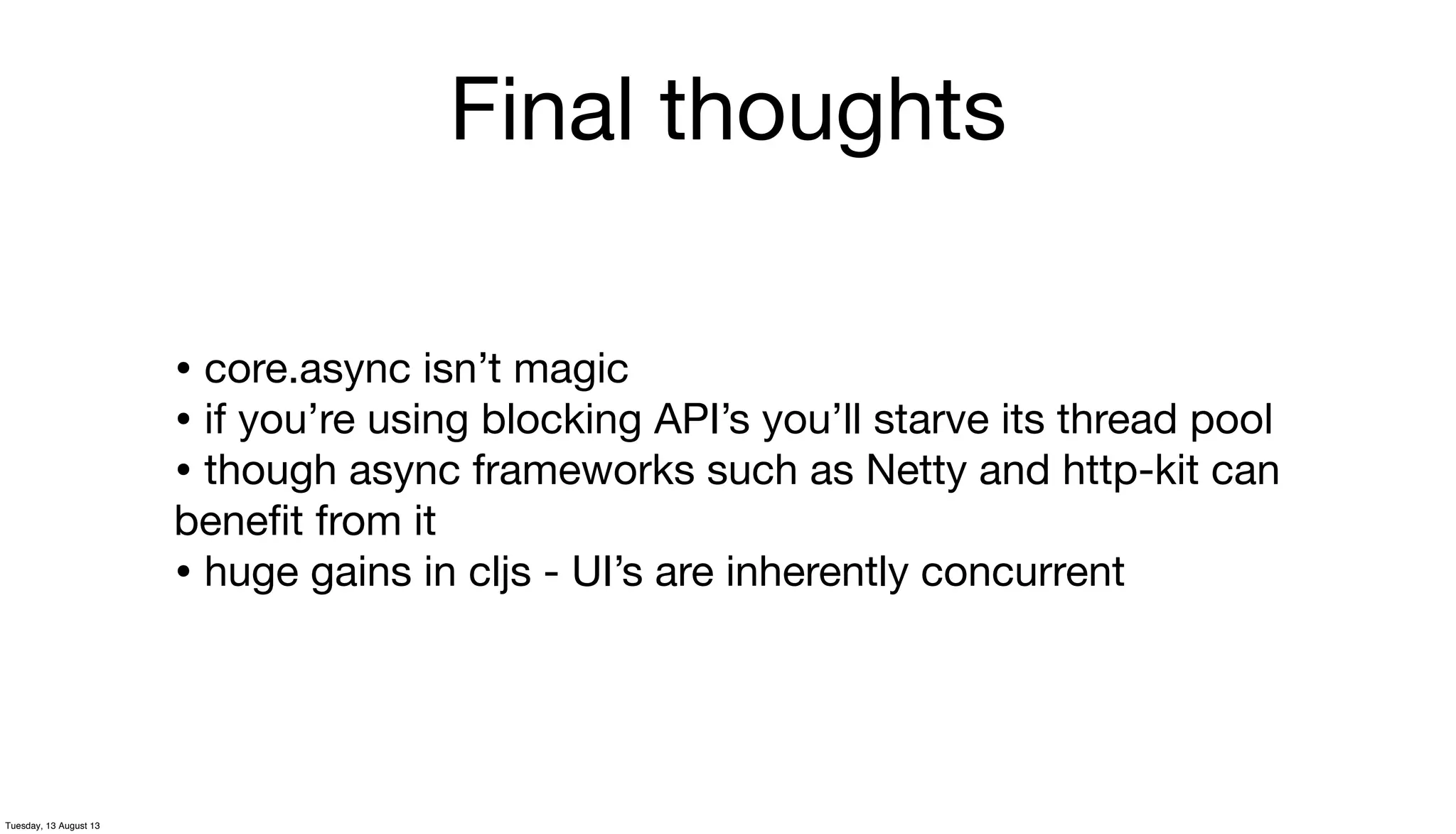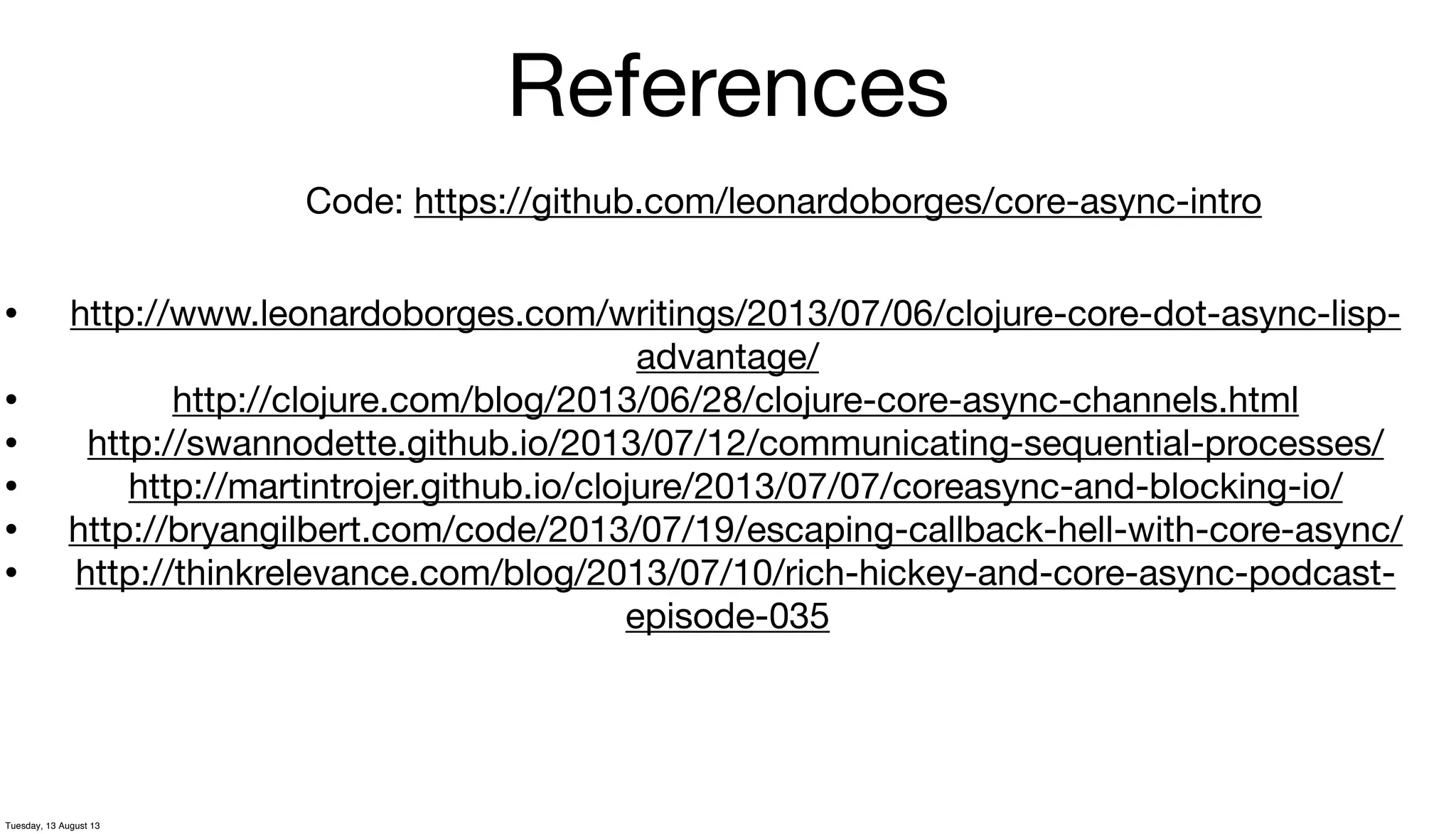The document provides an introduction to core.async, a Clojure library for concurrency and communication using asynchronous channels. It discusses how core.async is based on Communicating Sequential Processes (CSP) and channels, and provides two examples of using core.async channels to coordinate concurrent processes. The first example shows coordinating three independent search services, and the second coordinates three processes running at different speeds. Both examples are demonstrated in ClojureScript using core.async channels.
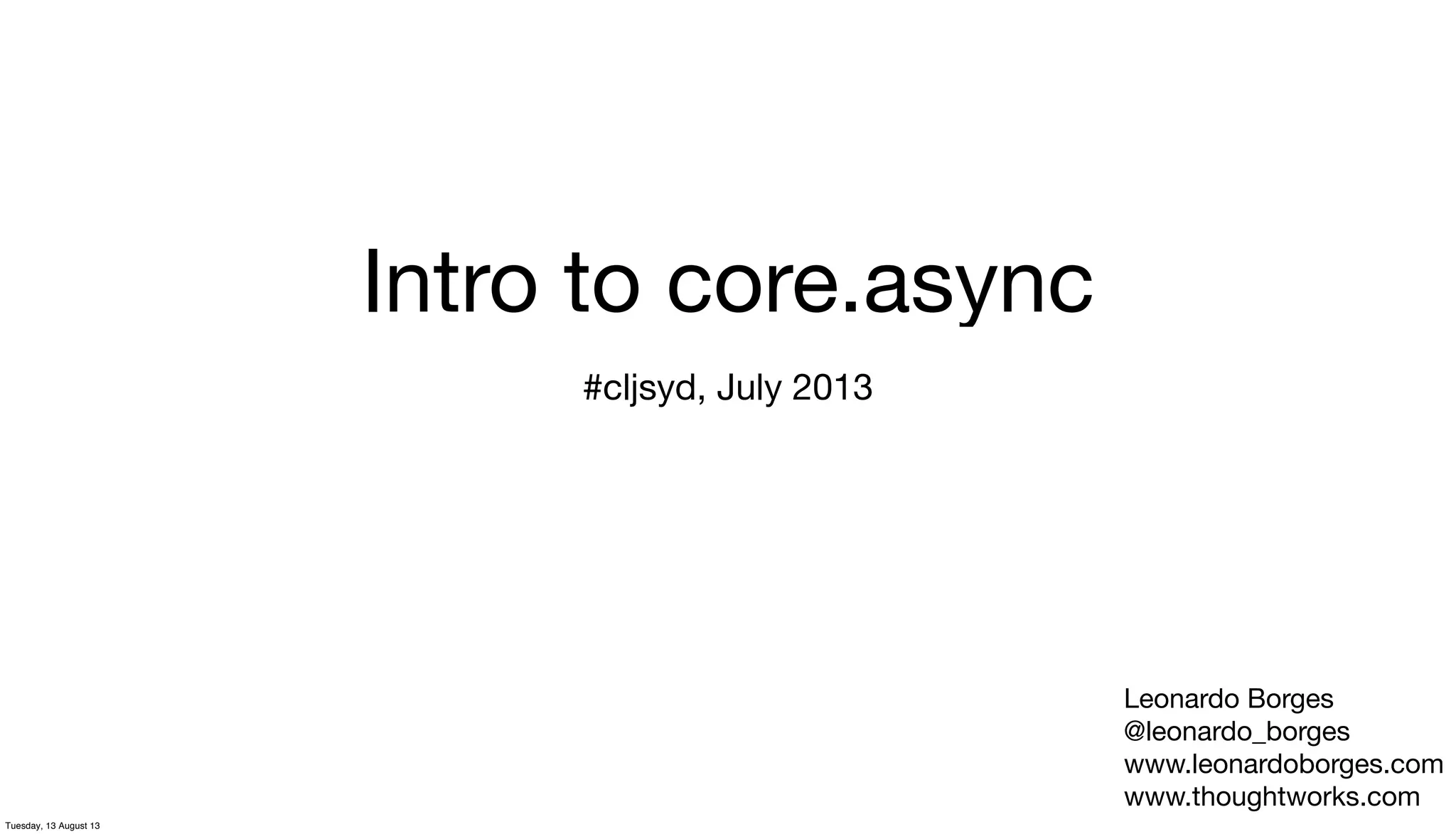

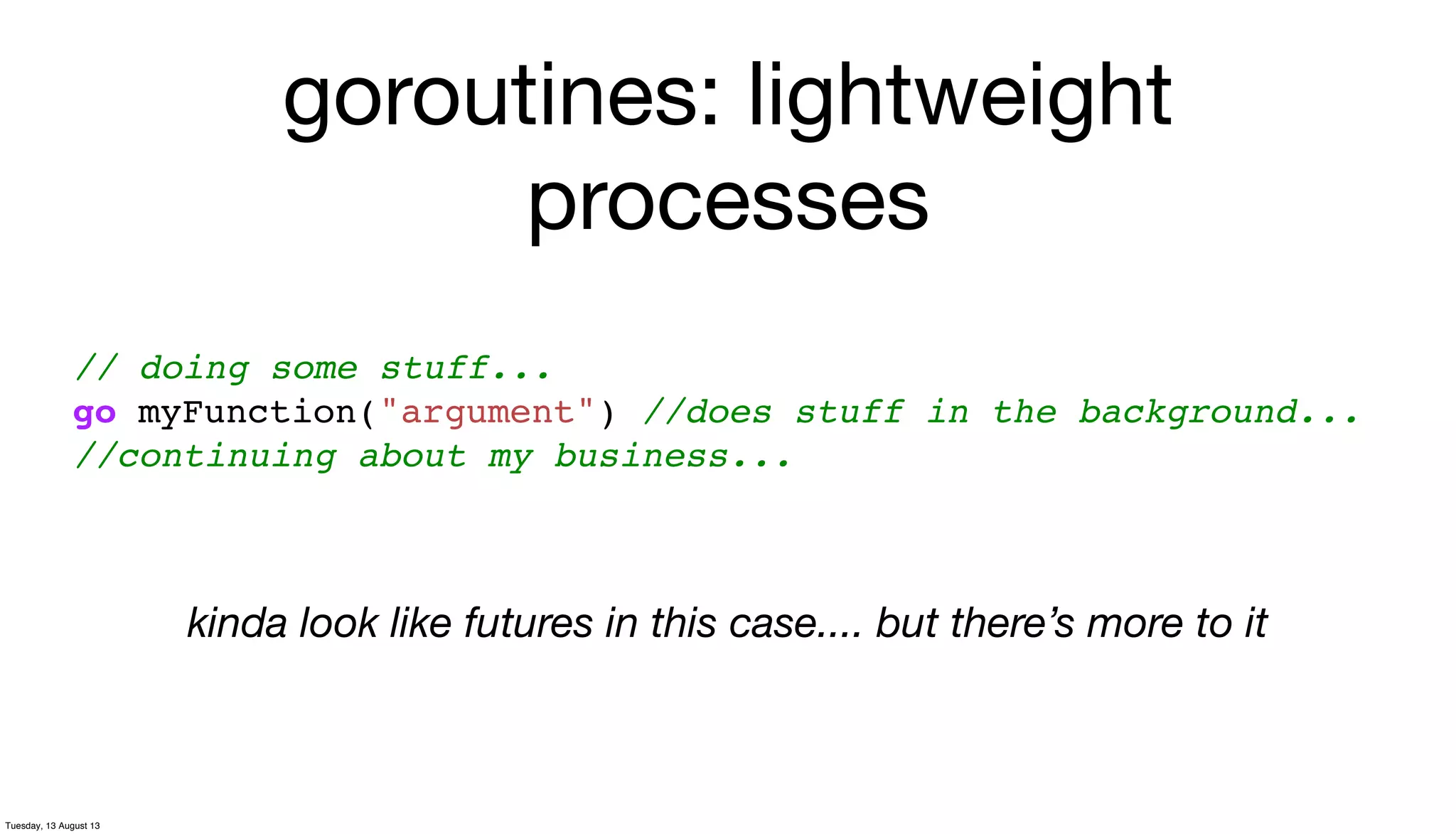
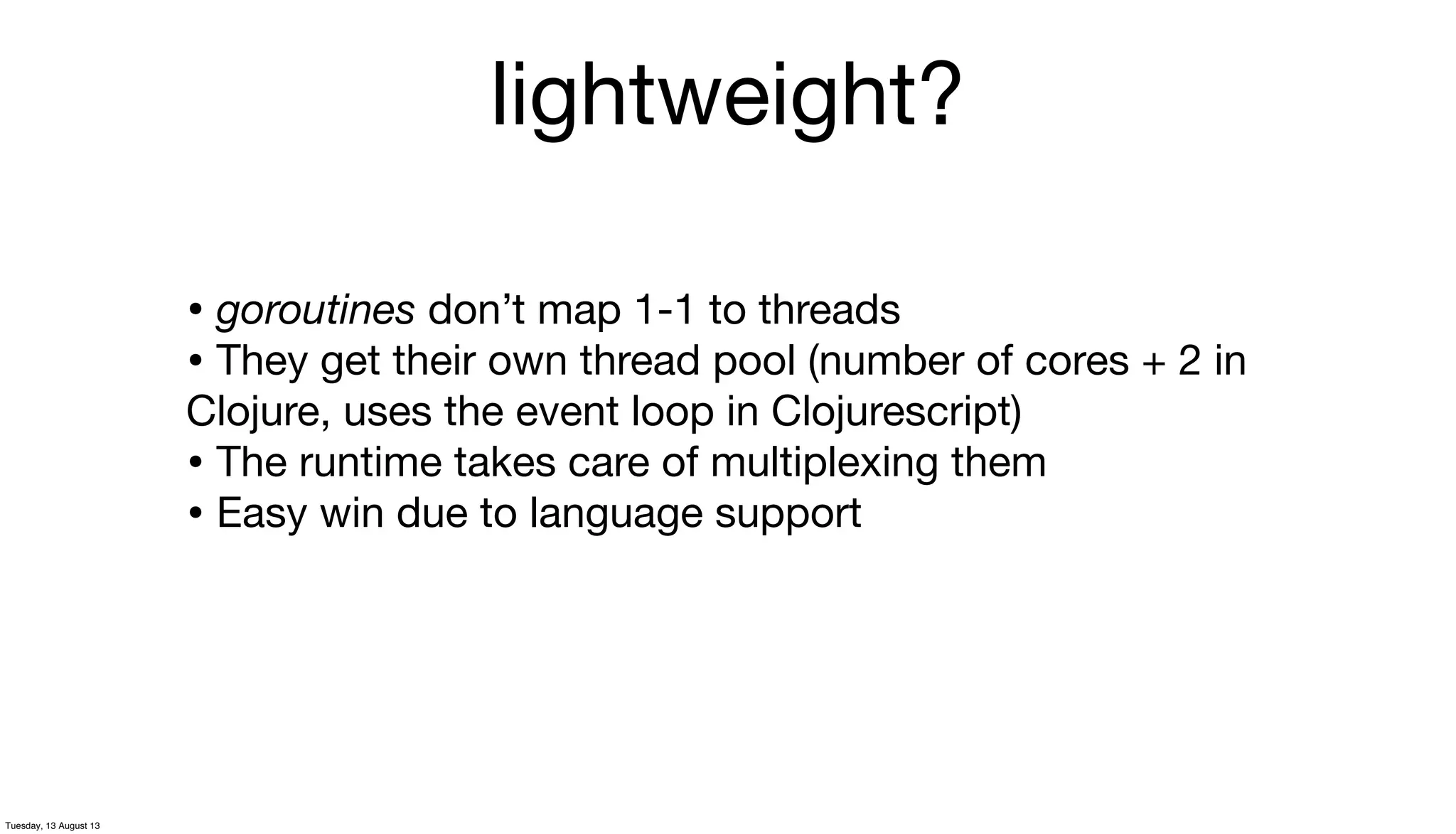
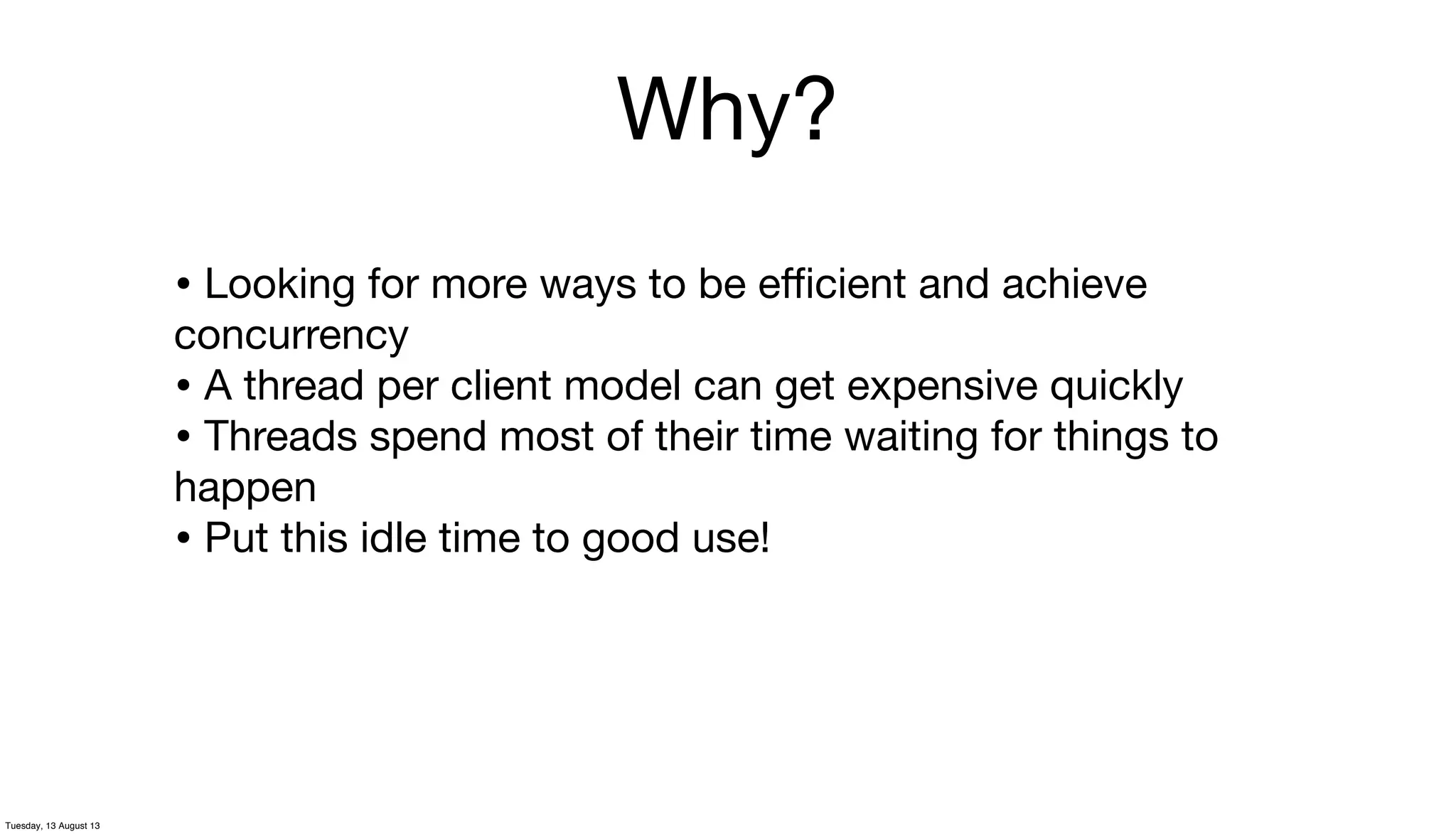

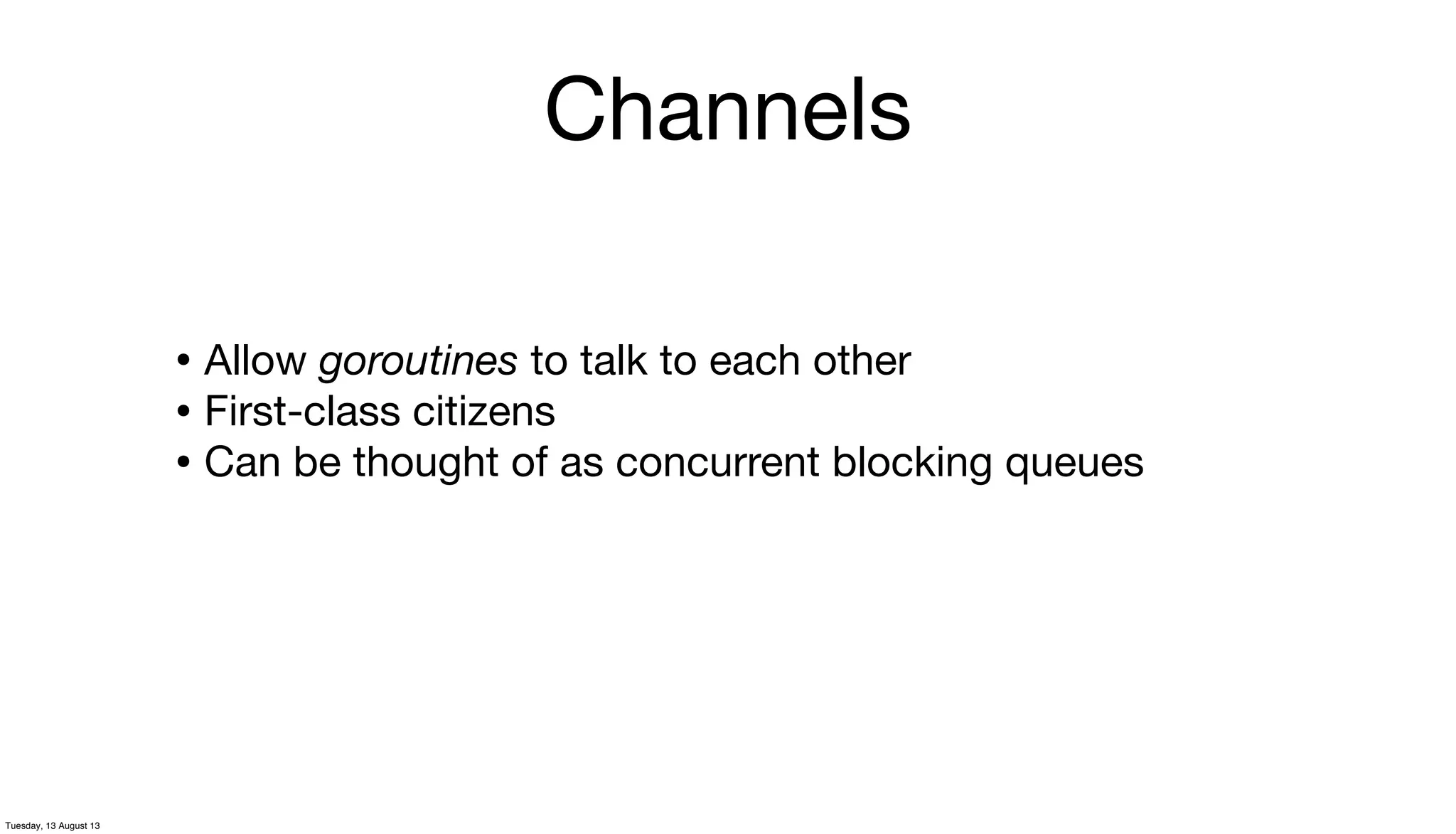
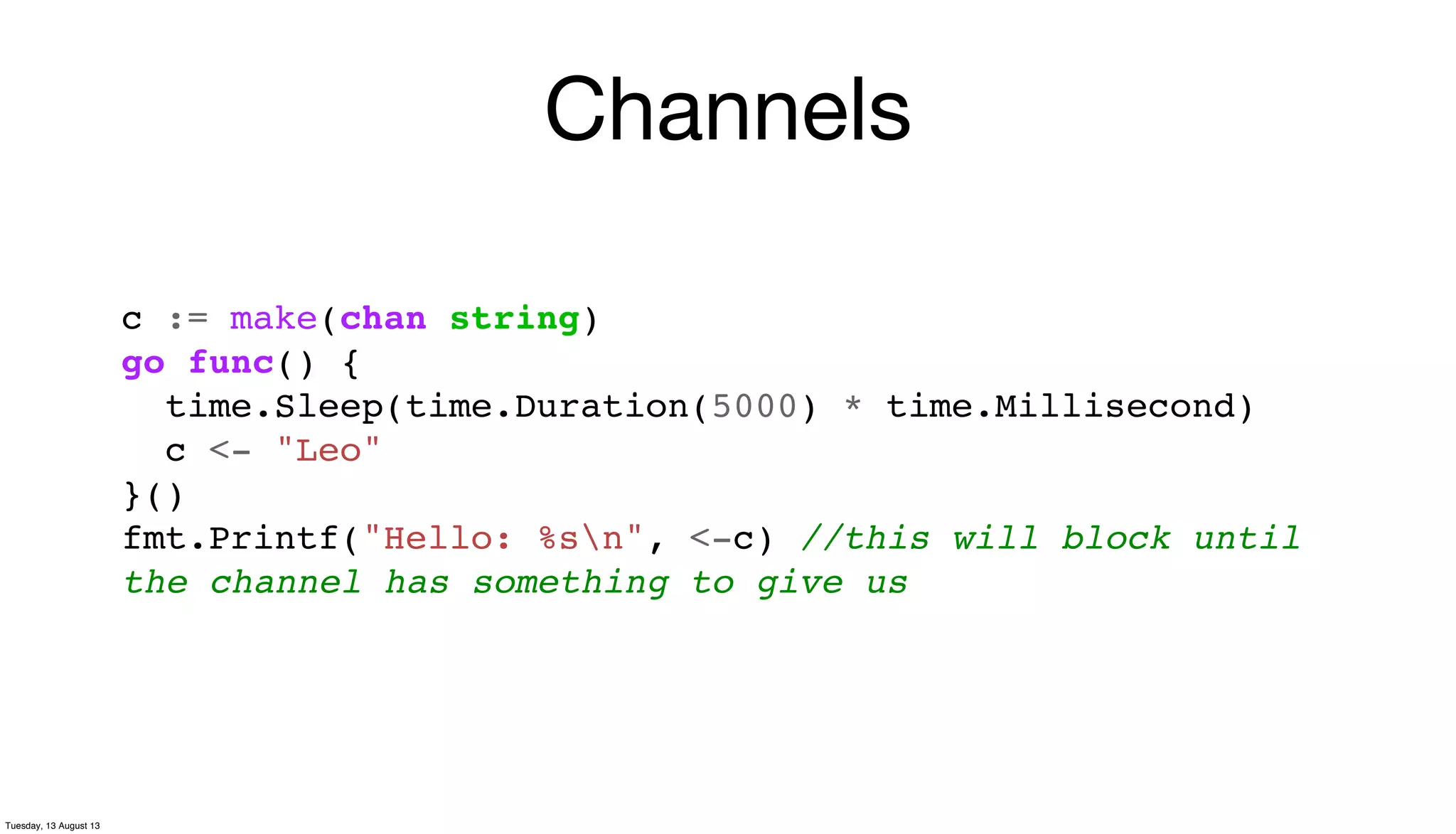
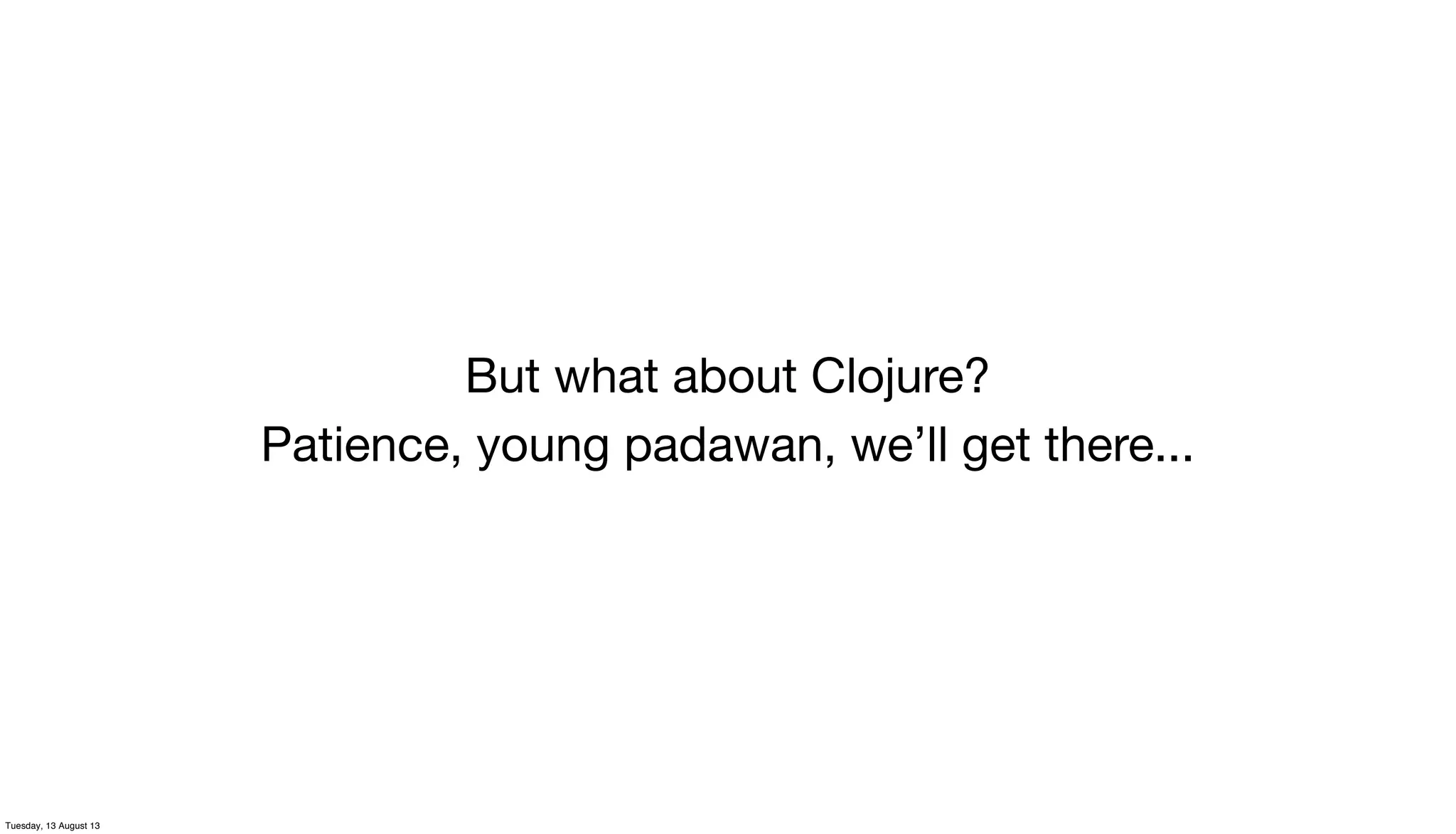
![Example 1 • We wish to implement a search service which is itself dependent on 3 other search services: web, images and video • Each individual service has unpredictable performance • Also, clients shouldn’t need to wait for slow services • Stolen from Rob Pike’s presentation, “Go Concurrency Patterns”[1] [1] http://bit.ly/go-concurrency-patterns Tuesday, 13 August 13](https://image.slidesharecdn.com/intro-core-async-130813080617-phpapp02/75/Intro-to-Clojure-s-core-async-10-2048.jpg)
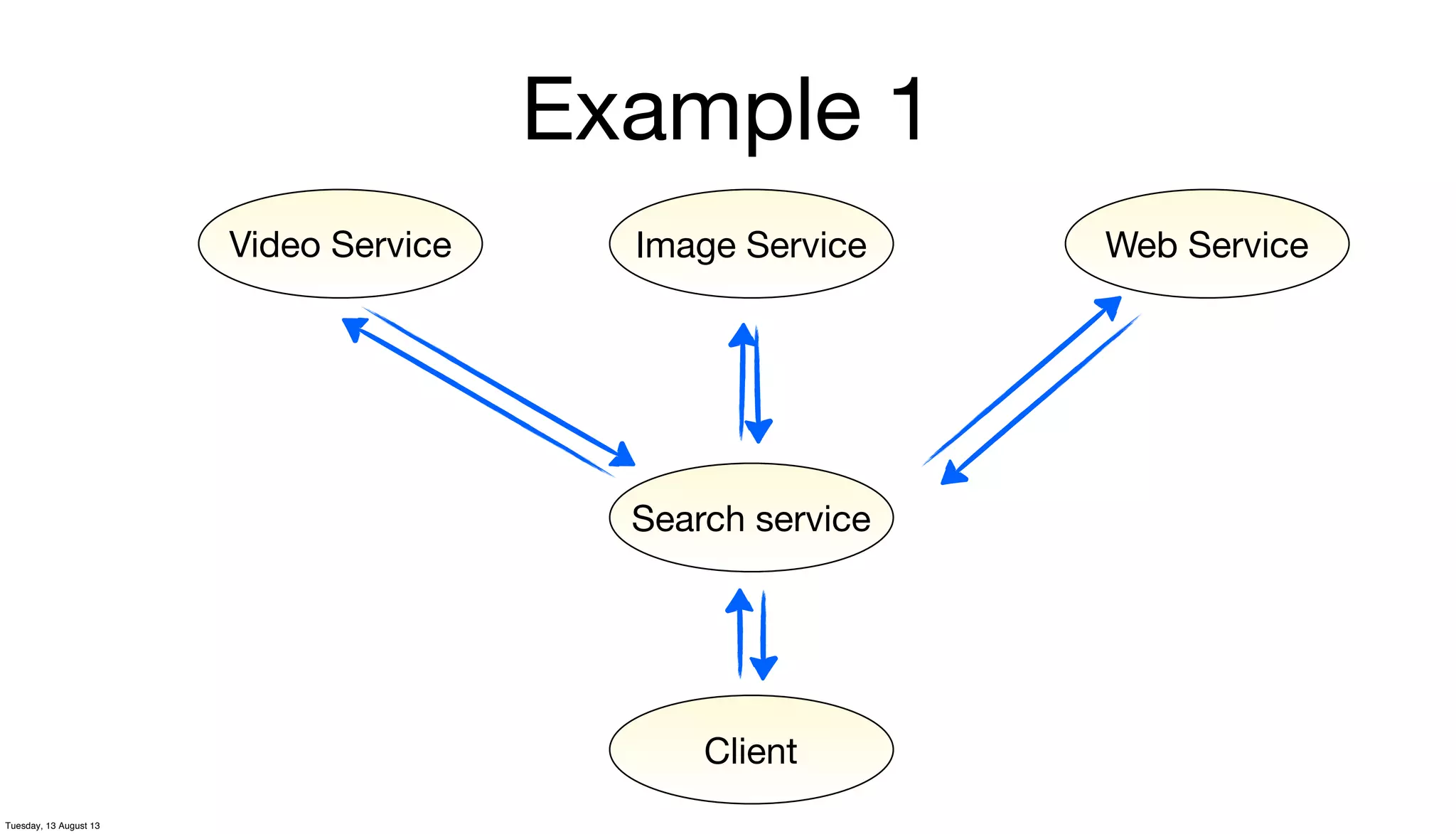
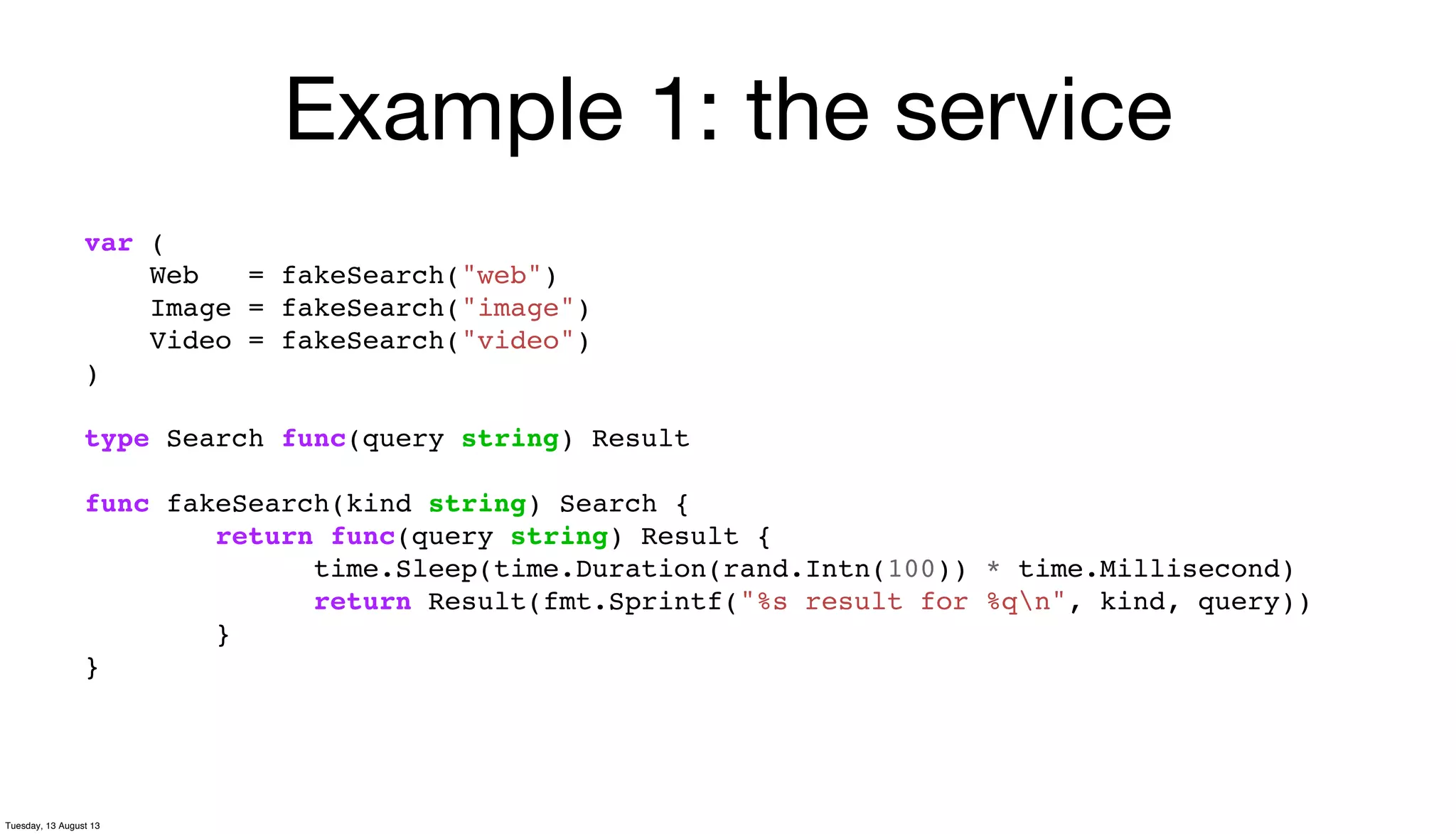
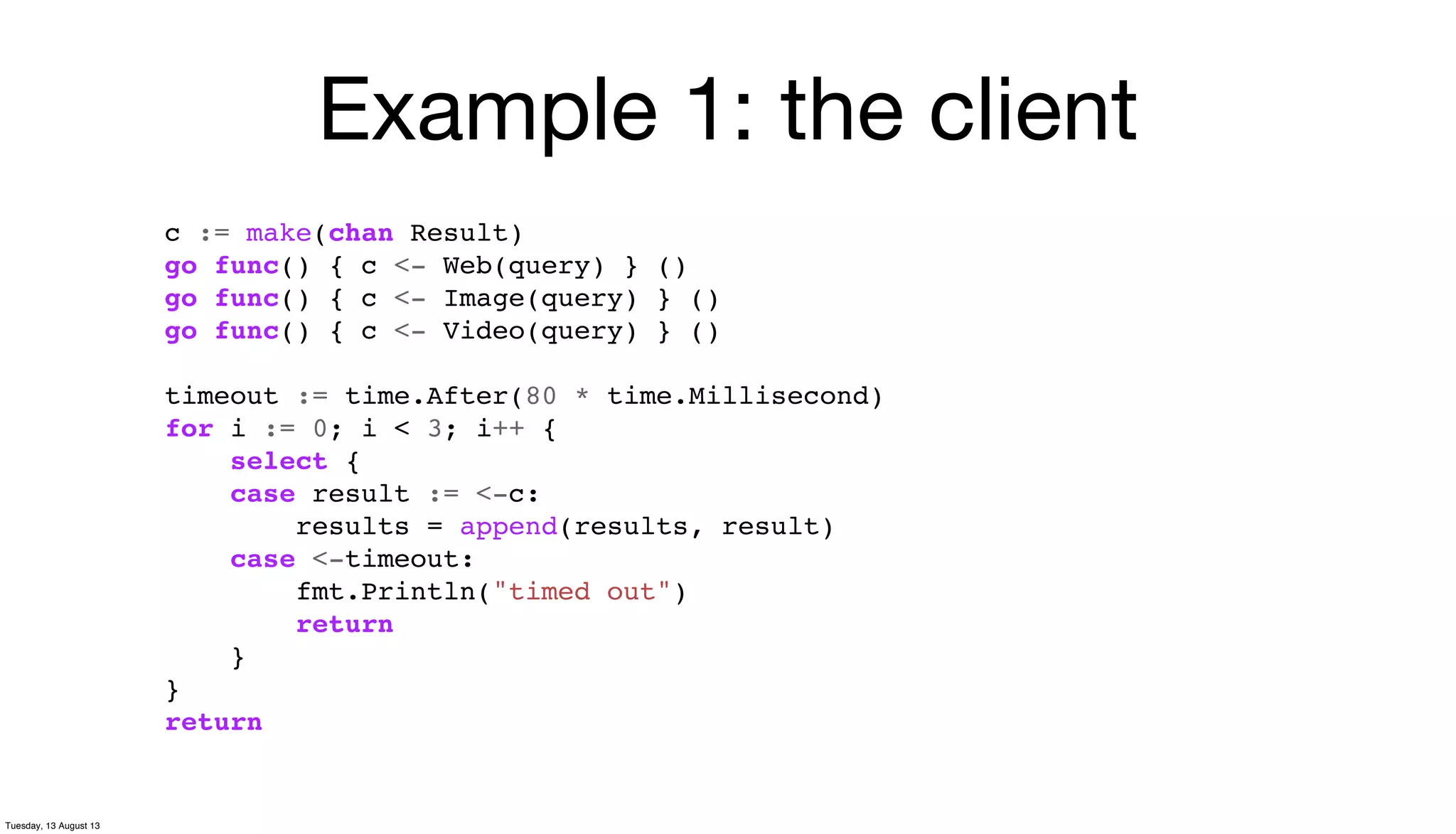
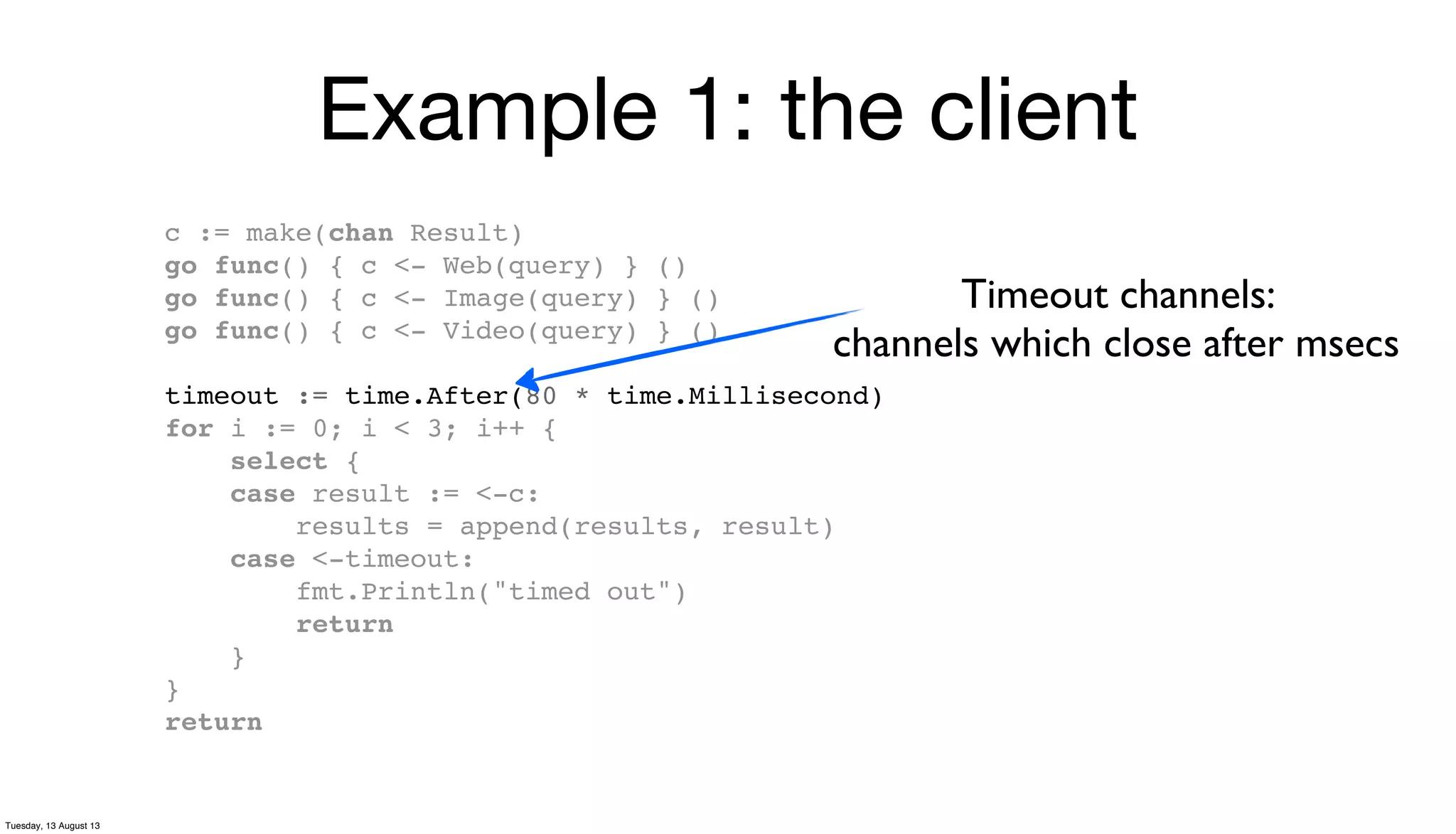
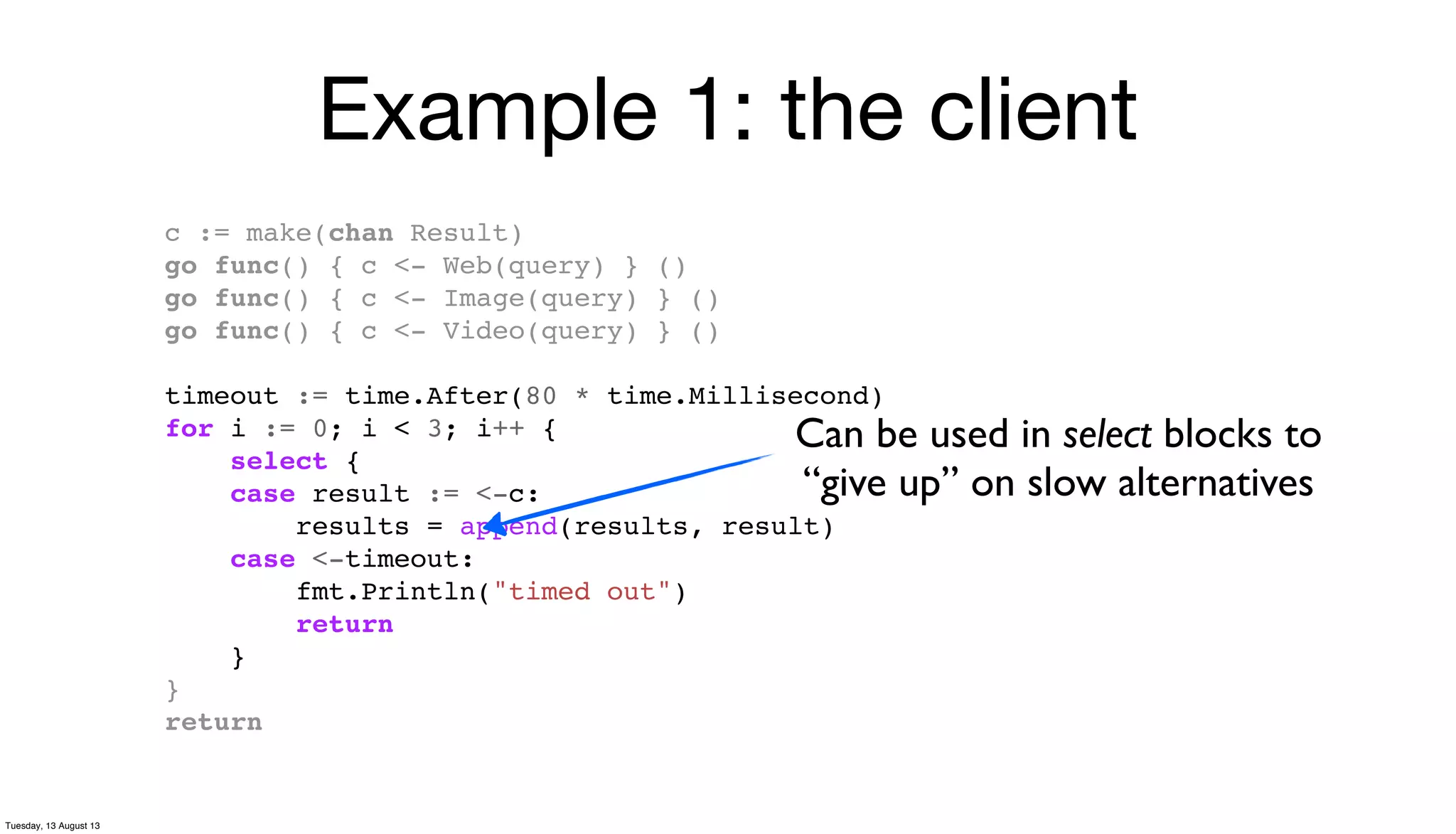
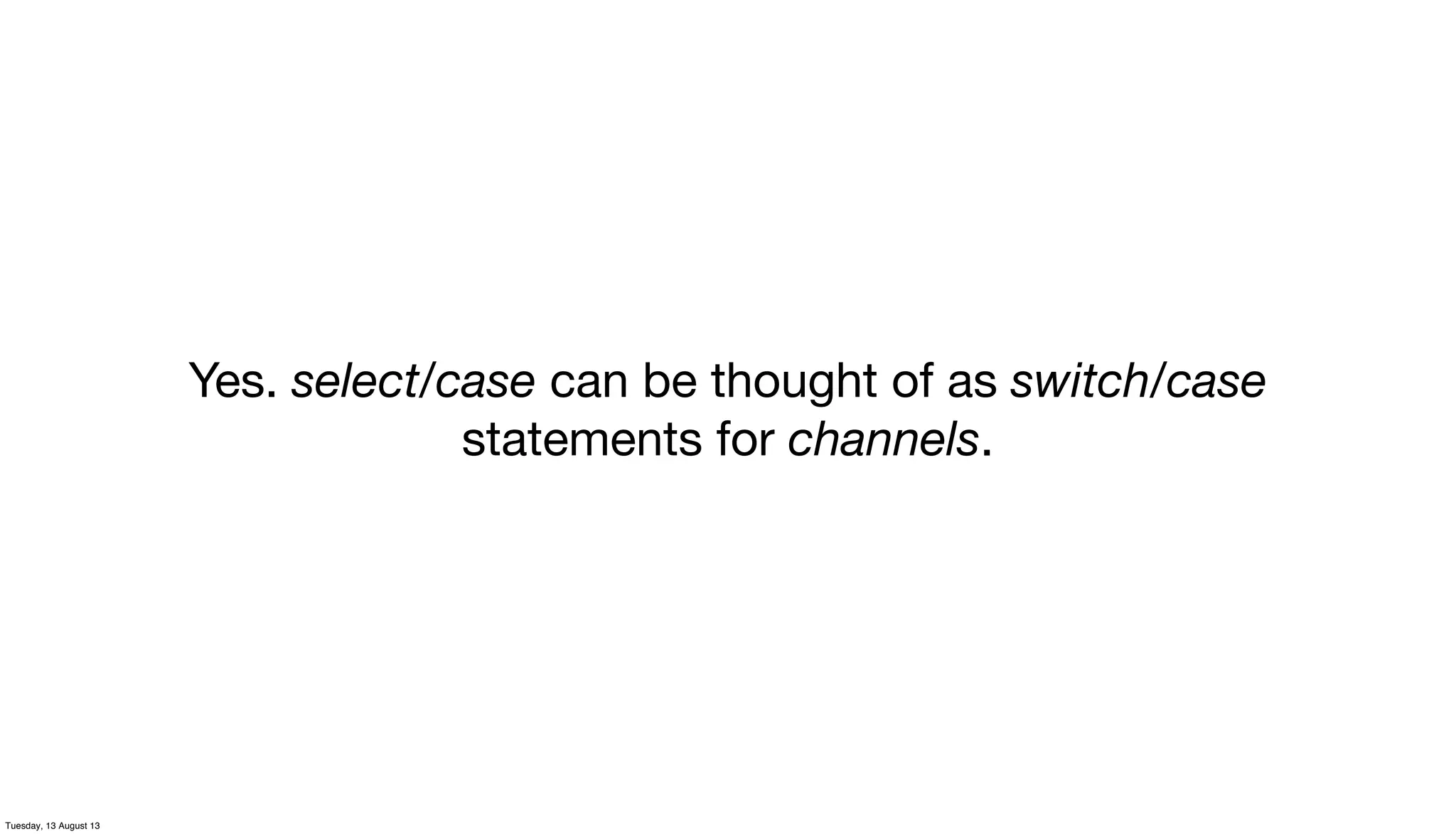
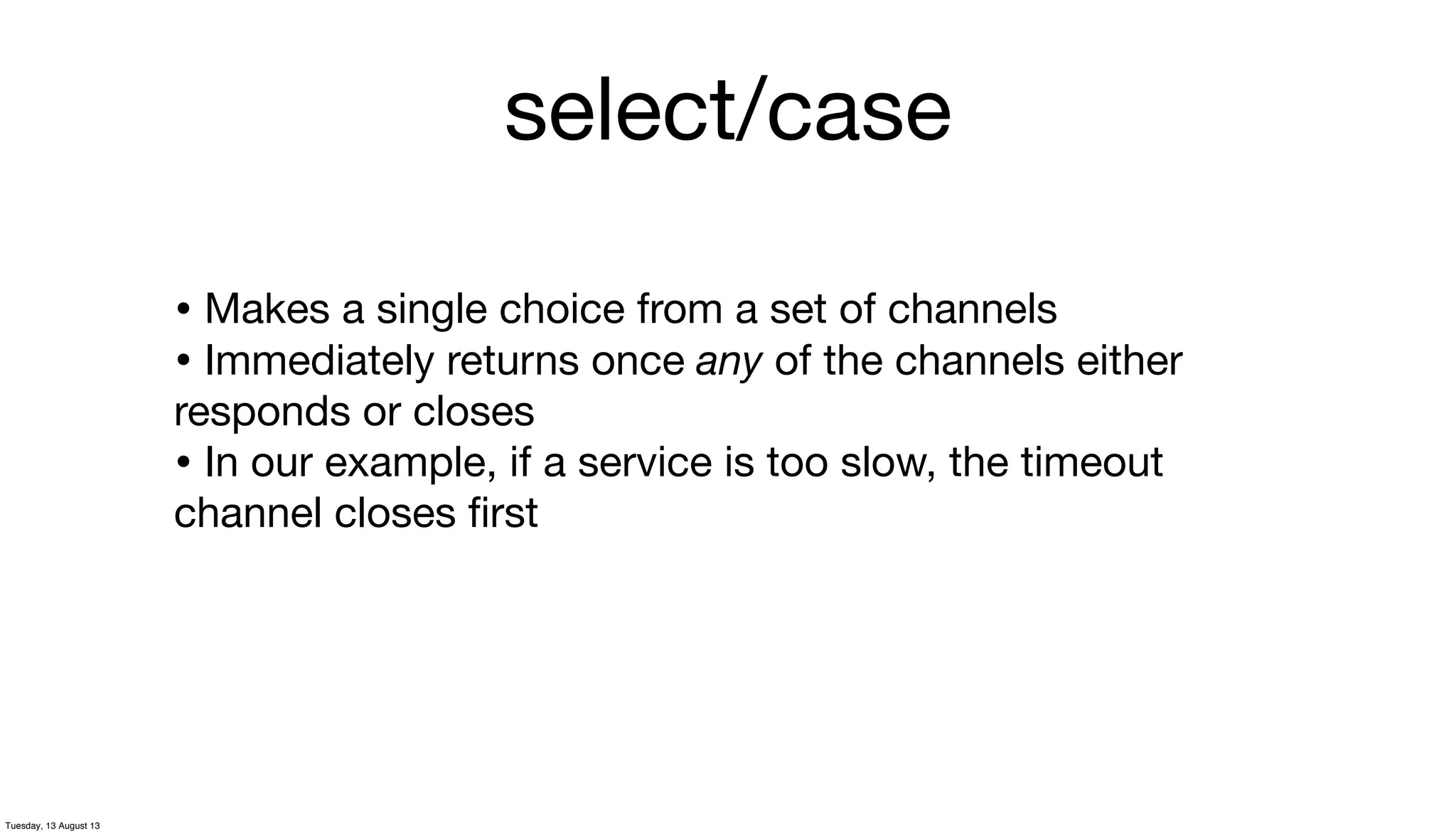
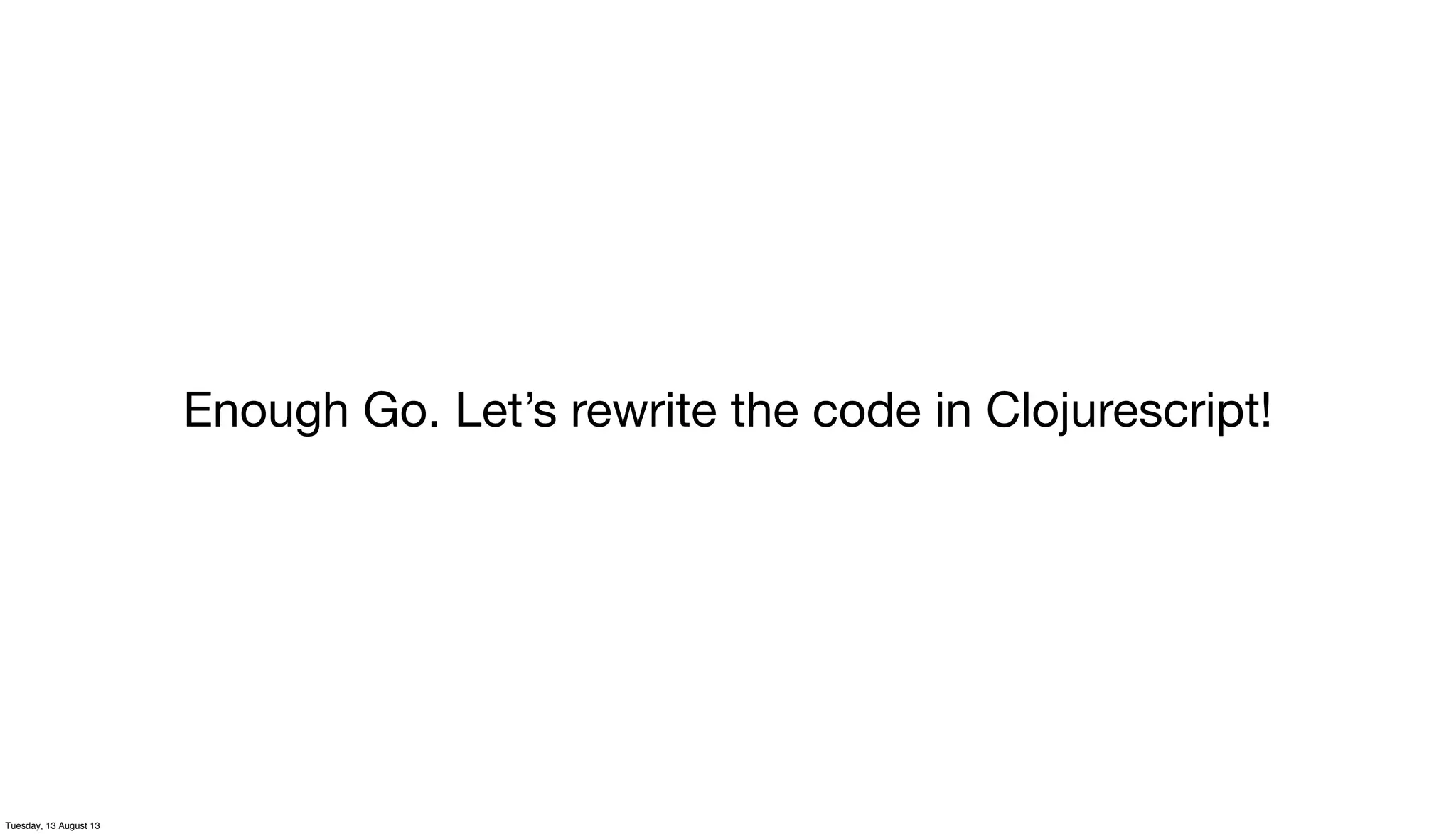
![Example 1: the service (defn fake-search [kind] (fn [query] (let [c (chan)] (go (<! (timeout (rand-int 100))) (>! c (str "<span>" kind " result for " query "</span>"))) c))) (def web (fake-search "Web")) (def image (fake-search "Image")) (def video (fake-search "Video")) Tuesday, 13 August 13](https://image.slidesharecdn.com/intro-core-async-130813080617-phpapp02/75/Intro-to-Clojure-s-core-async-19-2048.jpg)
![Example 1: the client (defn google [query] (let [c (chan) t (timeout 75)] (go (>! c (<! (web query)))) (go (>! c (<! (image query)))) (go (>! c (<! (video query)))) (go (loop [i 0 acc []] (if (> i 2) acc (recur (inc i) (conj acc (alt! [c t] ([v] v))))))))) Tuesday, 13 August 13](https://image.slidesharecdn.com/intro-core-async-130813080617-phpapp02/75/Intro-to-Clojure-s-core-async-20-2048.jpg)
![Example 1: the client (defn google [query] (let [c (chan) t (timeout 75)] (go (>! c (<! (web query)))) (go (>! c (<! (image query)))) (go (>! c (<! (video query)))) (go (loop [i 0 acc []] (if (> i 2) acc (recur (inc i) (conj acc (alt! [c t] ([v] v))))))))) Same deal: a timeout channel Tuesday, 13 August 13](https://image.slidesharecdn.com/intro-core-async-130813080617-phpapp02/75/Intro-to-Clojure-s-core-async-21-2048.jpg)
![Example 1: the client (defn google [query] (let [c (chan) t (timeout 75)] (go (>! c (<! (web query)))) (go (>! c (<! (image query)))) (go (>! c (<! (video query)))) (go (loop [i 0 acc []] (if (> i 2) acc (recur (inc i) (conj acc (alt! [c t] ([v] v))))))))) alt! - Clojure’s answer to Go’s select Tuesday, 13 August 13](https://image.slidesharecdn.com/intro-core-async-130813080617-phpapp02/75/Intro-to-Clojure-s-core-async-22-2048.jpg)

![Example 2 • From David Nolen’s CSP post [2] • In his words: “We will coordinate three independent processes running at three different speeds via a fourth process which shows the results of the coordination without any obvious use of mutation - only recursion” [2] http://bit.ly/david-nolen-csp • He also said this demo “should seem impossible for those familiar with JavaScript” - Challenge accepted! Tuesday, 13 August 13](https://image.slidesharecdn.com/intro-core-async-130813080617-phpapp02/75/Intro-to-Clojure-s-core-async-24-2048.jpg)
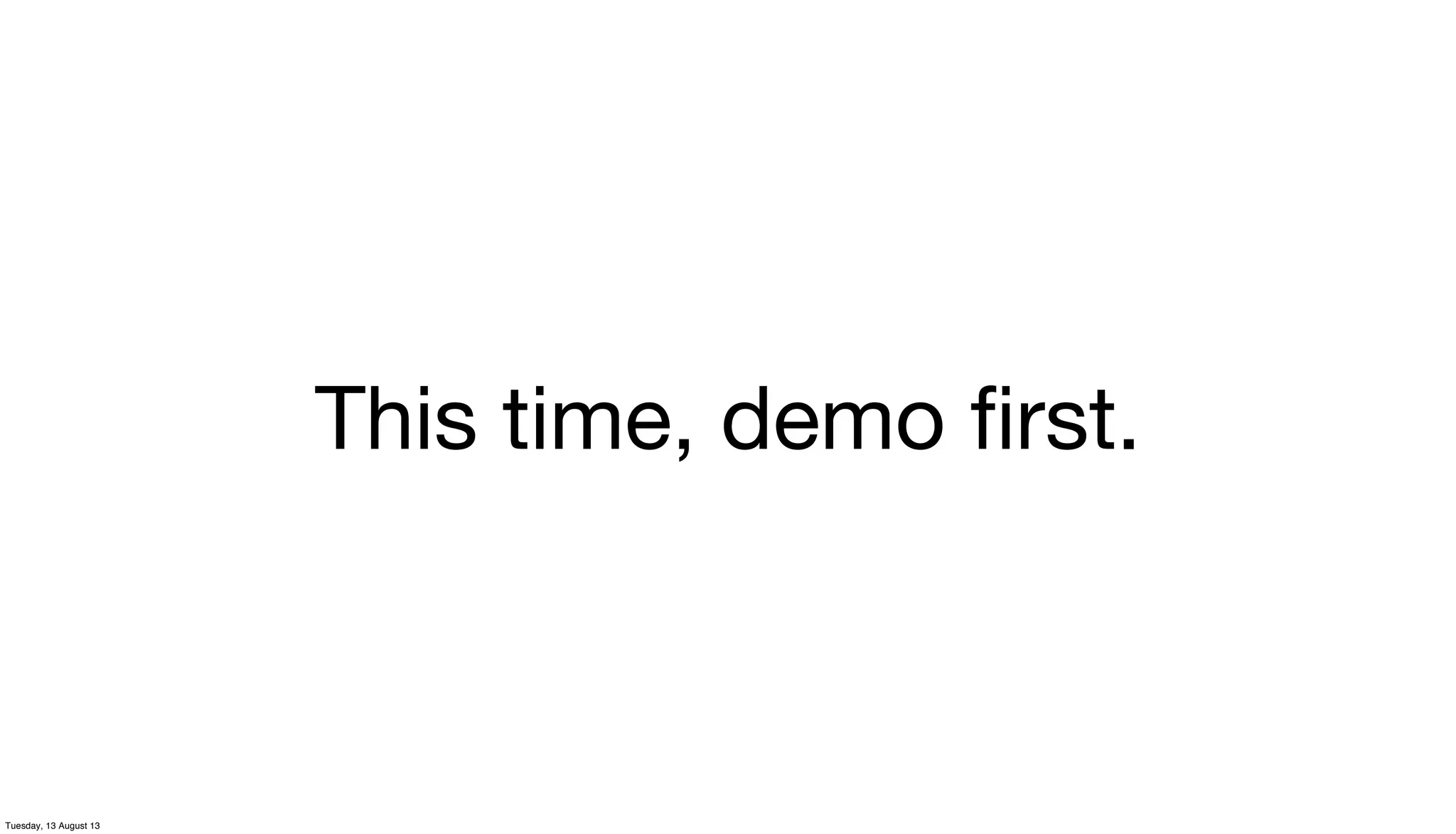
![Example 2: Clojurescript (def c (chan)) (defn render [q] (apply str (for [p (reverse q)] (str "<div class='proc-" p "'>Process " p "</div>")))) (go (while true (<! (async/timeout 250)) (>! c 1))) (go (while true (<! (async/timeout 1000)) (>! c 2))) (go (while true (<! (async/timeout 1500)) (>! c 3))) (defn peekn "Returns vector of (up to) n items from the end of vector v" [v n] (if (> (count v) n) (subvec v (- (count v) n)) v)) (let [out (by-id "messages")] (go (loop [q []] (set-html! out (render q)) (recur (-> (conj q (<! c)) (peekn 10)))))) Tuesday, 13 August 13](https://image.slidesharecdn.com/intro-core-async-130813080617-phpapp02/75/Intro-to-Clojure-s-core-async-26-2048.jpg)
![Example 2: Clojurescript (def c (chan)) (defn render [q] (apply str (for [p (reverse q)] (str "<div class='proc-" p "'>Process " p "</div>")))) (go (while true (<! (async/timeout 250)) (>! c 1))) (go (while true (<! (async/timeout 1000)) (>! c 2))) (go (while true (<! (async/timeout 1500)) (>! c 3))) (defn peekn "Returns vector of (up to) n items from the end of vector v" [v n] (if (> (count v) n) (subvec v (- (count v) n)) v)) (let [out (by-id "messages")] (go (loop [q []] (set-html! out (render q)) (recur (-> (conj q (<! c)) (peekn 10)))))) The three independent, different speed processes Tuesday, 13 August 13](https://image.slidesharecdn.com/intro-core-async-130813080617-phpapp02/75/Intro-to-Clojure-s-core-async-27-2048.jpg)
![Example 2: Clojurescript (def c (chan)) (defn render [q] (apply str (for [p (reverse q)] (str "<div class='proc-" p "'>Process " p "</div>")))) (go (while true (<! (async/timeout 250)) (>! c 1))) (go (while true (<! (async/timeout 1000)) (>! c 2))) (go (while true (<! (async/timeout 1500)) (>! c 3))) (defn peekn "Returns vector of (up to) n items from the end of vector v" [v n] (if (> (count v) n) (subvec v (- (count v) n)) v)) (let [out (by-id "messages")] (go (loop [q []] (set-html! out (render q)) (recur (-> (conj q (<! c)) (peekn 10)))))) The fourth process, responsible for rendering Tuesday, 13 August 13](https://image.slidesharecdn.com/intro-core-async-130813080617-phpapp02/75/Intro-to-Clojure-s-core-async-28-2048.jpg)
![Example 2: Javascript - part I var messageChannel = new MessageChannel(); var tasks = []; messageChannel.port1.onmessage = function(msg) { tasks.shift()(); }; var c = []; function publishValue(value, timeout) { setTimeout(function() { c.push(value); publishValue(value, timeout); }, timeout); } publishValue(1, 250); publishValue(2, 1000); publishValue(3, 1500); Tuesday, 13 August 13](https://image.slidesharecdn.com/intro-core-async-130813080617-phpapp02/75/Intro-to-Clojure-s-core-async-29-2048.jpg)
![Example 2: Javascript - part II function renderValues(q) { tasks.push(function() { var v = c.shift(); if (v) { q.unshift(v); q = q.slice(0,10); var result = q.reduce(function(acc,p){ return acc+ "<div class='proc-" + p + "'>Process " + p + "</div>"; },""); document.getElementById("messages1").innerHTML = result; } renderValues(q); }); messageChannel.port2.postMessage(0); } renderValues([]); Tuesday, 13 August 13](https://image.slidesharecdn.com/intro-core-async-130813080617-phpapp02/75/Intro-to-Clojure-s-core-async-30-2048.jpg)
![Cljs vs. js - couldn’t resist it :) (def c (chan)) (defn render [q] (apply str (for [p (reverse q)] (str "<div class='proc-" p "'>Process " p "</div>")))) (go (while true (<! (async/timeout 250)) (>! c 1))) (go (while true (<! (async/timeout 1000)) (>! c 2))) (go (while true (<! (async/timeout 1500)) (>! c 3))) (defn peekn "Returns vector of (up to) n items from the end of vector v" [v n] (if (> (count v) n) (subvec v (- (count v) n)) v)) (let [out (by-id "messages")] (go (loop [q []] (set-html! out (render q)) (recur (-> (conj q (<! c)) (peekn 10)))))) var messageChannel = new MessageChannel(); var tasks = []; messageChannel.port1.onmessage = function(msg) { tasks.shift()(); }; var c = []; function publishValue(value, timeout) { setTimeout(function() { c.push(value); publishValue(value, timeout); }, timeout); } publishValue(1, 250); publishValue(2, 1000); publishValue(3, 1500); function renderValues(q) { tasks.push(function() { var v = c.shift(); if (v) { q.unshift(v); q = q.slice(0,10); var result = q.reduce(function(acc,p){ return acc+ "<div class='proc-" + p + "'>Process " + p + "</div>"; },""); document.getElementById("messages1").innerHTML = result; } renderValues(q); }); messageChannel.port2.postMessage(0); } renderValues([]); Tuesday, 13 August 13](https://image.slidesharecdn.com/intro-core-async-130813080617-phpapp02/75/Intro-to-Clojure-s-core-async-31-2048.jpg)

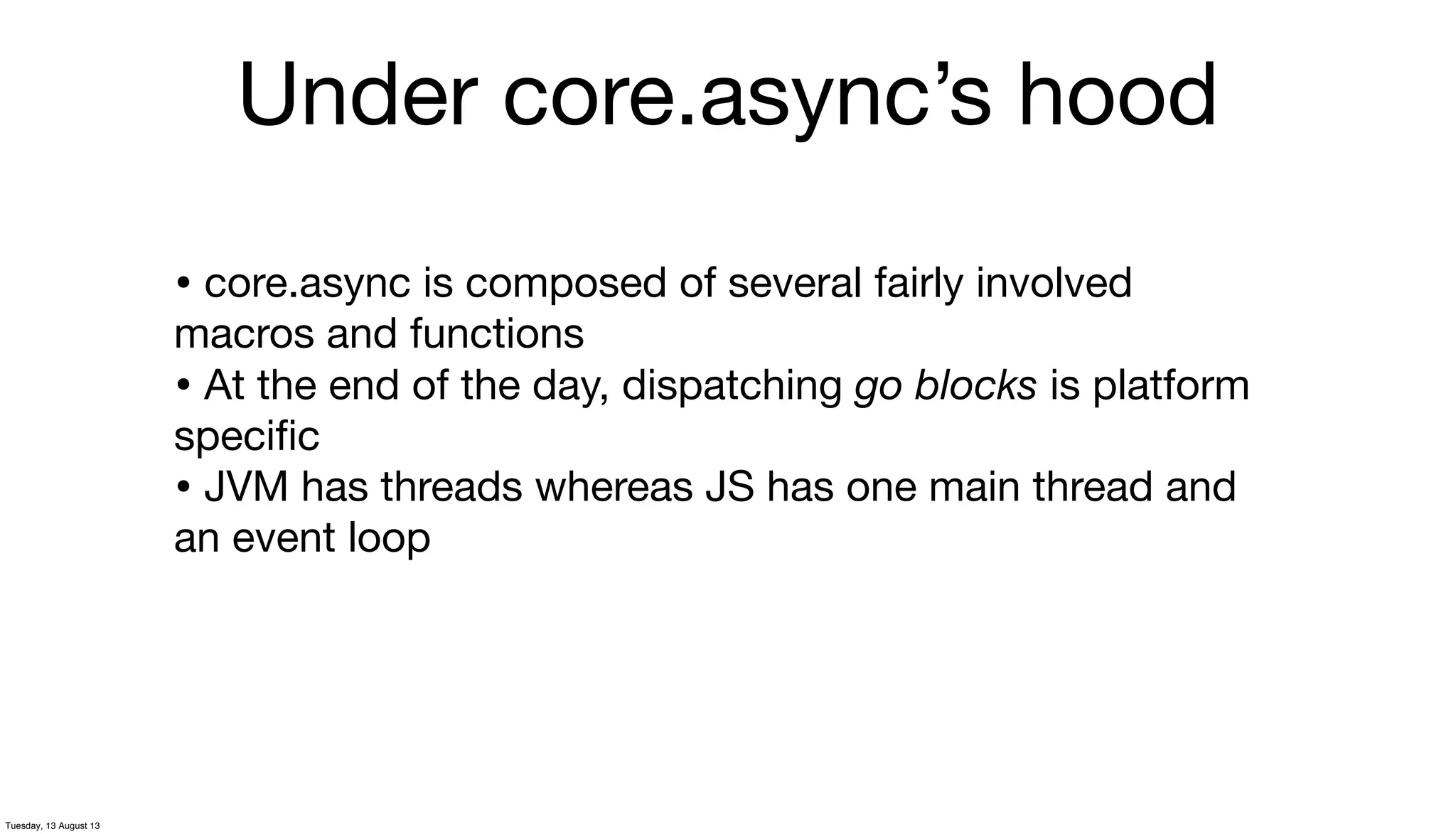
![• the Javascript implementation dispatches like this: (ns cljs.core.async.impl.dispatch) ... (defn run [f] (cond (exists? js/MessageChannel) (queue-task f) (exists? js/setImmediate) (js/setImmediate f) :else (js/setTimeout f 0))) Under core.async’s hood Tuesday, 13 August 13](https://image.slidesharecdn.com/intro-core-async-130813080617-phpapp02/75/Intro-to-Clojure-s-core-async-34-2048.jpg)
![• The JVM on the other hand uses java.util.concurrent.Executors (ns ^{:skip-wiki true} clojure.core.async.impl.dispatch (:require [clojure.core.async.impl.protocols :as impl] [clojure.core.async.impl.exec.threadpool :as tp])) ... (def executor (delay (tp/thread-pool-executor))) (defn run "Runs Runnable r in a thread pool thread" [^Runnable r] (impl/exec @executor r)) Under core.async’s hood Tuesday, 13 August 13](https://image.slidesharecdn.com/intro-core-async-130813080617-phpapp02/75/Intro-to-Clojure-s-core-async-35-2048.jpg)
